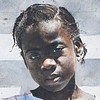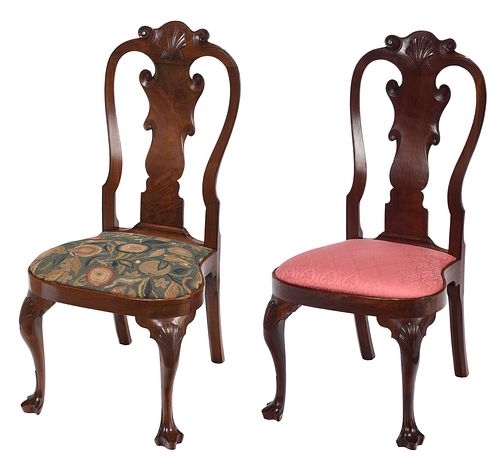- Important Private Virginia Estate
Very Rare Pair of Graeme Park Philadelphia Queen Anne Carved Walnut Compass Seat Side Chairs
Bid Increments
| Price | Bid Increment |
|---|---|
| $0 | $25 |
| $100 | $50 |
| $1,000 | $100 |
| $2,000 | $200 |
| $3,000 | $250 |
| $5,000 | $500 |
| $10,000 | $1,000 |
| $20,000 | $2,000 |
| $50,000 | $5,000 |
| $100,000 | $10,000 |
1740-1760, each with scrolled and shell carved crest over a figured splat with four scrolled volutes, set on shell carved legs with trifid feet, upholstered compass seats, one retaining early and probably original needlework upholstery and under upholstery marked with "IV" and matching slip seat marked "IV", 42-1/2 x 21 x 22-1/2 in.
Provenance:
Probable line of descent, needlework upholstered example:
Dr. Thomas Graeme (1688-1772), Graeme Park, Horsham, Pennsylvania;
Elizabeth Graeme Fergusson (1737-1801), Graeme Park, daughter;
Dr. William Smith (1746-1822), Graeme Park, by transfer from above, husband of niece;
Samuel Penrose (1748-1833), Graeme Park, by purchase from above;
William Penrose (1782-1863), Graeme Park, by purchase from above in 1821, son;
Ann (Penrose) Iredell (1811-c.1881), Graeme Park and Davis Grove Road, Horsham, daughter;
Hannah (Iredell) Twining (b. 1839), Davis Grove Road, Horsham, Pennsylvania, daughter;
Ida (Twining) Jones (c.1873-1968), Green Meadows Farm, Warrington, Pennsylvania, daughter;
Thence by descent;
Sold, Sotheby's, New York, 22 October 1983, lot 254;
Private Collection, purchased from above;
Sold, Sotheby's, New York, 17 and 19 January, 1997, lot 778 for $118,000;
Leigh Keno, Inc., New York;
Property of Eric Martin Wunsch;
Sold Christie's New York, September 25, 2013 lot 8 for $40,000 hammer
Pink upholstered example:
Probably made for Dr. Thomas Graeme (1688-1772), Graeme Park, Horsham, Pennsylvania
Mrs. J. Insley Blair (Natalie Knowlton) (1883-1951), Manhattan and Tuxedo Park, New York
Natica (Blair) Lorillard (1913-1955), daughter
Screven Lorillard (1909-1979), husband
Alice (Whitney) Lorillard (1919-2015), wife
Thence by descent in the family
Collection of Mrs. J. Insley Blair, sold Christie's, New York, January 20, 2017, lot 542 for $50,000
Important Private Virginia Estate
Note: The Christie's catalog entry for the needlework upholstered example records that "With its original needlework upholstery cover and a notable provenance, this side chair is an important and rare survival from mid-eighteenth century Philadelphia. As indicated by the Roman numerals on its frame and slip-seat, the chair was originally part of a larger set of at least nine chairs of which two or three others are known. These comprise a chair at Colonial Williamsburg, a single example advertised in 1956, and a third, which may or may not duplicate the previous example, published in 1960 and sold in 1998 (David Stockwell, advertisement, The Magazine Antiques (September 1956), p. 173; Barbara Snow, "Living with Antiques: The Home of Mr. and Mrs. J. Stanley Lee, Newtown, Pennsylvania," The Magazine Antiques (September 1960), p. 240; Wechsler's Auction House, Washington D.C., 17 January 1998, lot 185). The first three are illustrated with needlework seat covers that are virtually identical to that made for the chair offered here. With green grounds and stylized leaves and flowers worked in shades of red, yellow, blue and green threads, these covers represent the original coverings. As discussed by Morrison H. Heckscher, this set is distinguished by the broad width of its splats. A side chair now at the Metropolitan Museum of Art with slightly variant shell carving but an identical splat was most likely made in the same shop and, with a similar historical association as the set represented by the chair offered here, may have furnished the same eighteenth-century household (Morrison H. Heckscher, American Furniture: The Queen Anne and Chippendale Styles (New York, 1985), pp. 82-83, cat. 38).
This chair descended to the twentieth century with a history of being part of the furnishings of Graeme Park in Horsham, Pennsylvania, a provenance that is supported by the other known chairs from the same set, all of which were also associated with the historic house by their later owners. Originally called Fountain Low and probably constructed for utilitarian purposes, Graeme Park was built in 1722 for Lieutenant-Governor Sir William Keith (1669-1749) on his 1,735 acre estate about twenty five miles north of Philadelphia. Keith returned to England in 1728 and, while the chairs were later thought to have been owned by Keith himself, they date to the period following the house's purchase by Keith's son-in-law, Dr. Thomas Graeme (1688-1772) in 1739. Graeme had accompanied Keith to Philadelphia in 1717 and two years later married Keith's step-daughter, Ann Diggs (d. 1765). After purchasing the house, Graeme re-named the estate and began its transformation into a Georgian summer mansion by re-planting the gardens and retrofitting the house with interior panelling. For almost a hundred years after Dr. Graeme's death in 1772, this set of chairs appears to have remained intact on the estate and owned by successive proprietors of Graeme Park. Graeme bequeathed the estate to his daughter, Elizabeth Graeme Fergusson (1737-1801), a respected poet and scholar who hosted America's first salon, attended by Philadelphia's leading intellectual figures such as Dr. Benjamin Rush and Francis Hopkinson. Elizabeth has been credited with working the floral needlework covers on the chairs, but it is also possible that they were stitched by her mother, Ann Diggs Graeme, especially if the chairs were made closer to 1740 than 1760. Evidence of the latter's proficiency in the needlework arts is suggested by "the Crocadile [sic] in Needle Work by Mrs. Graeme," which was in a bed chamber in 1778; interestingly, the same room had "6 chairs with the old Arm chair," possibly a reference to some of the set represented by this chair. During the Revolutionary War, Elizabeth's husband, Hugh Fergusson, was a Loyalist and deserted not only the country, but his wife. In 1791, Elizabeth transferred ownership of the estate to Dr. William Smith (1746-1822), her niece's husband, and in exhchange, he managed her finances. In 1801, Smith sold the parcel of land that contained the mansion house to Samuel Penrose (1748-1833), a prominent local Quaker farmer, and, in 1821 Samuel sold it to his son, William Penrose (1782-1863), who had been living on the estate with his wife in a separate house since their marriage in 1810. For much of the nineteenth century, Graeme Park was largely uninhabited and looked after by the Penrose family, a circumstance that probably contributed to the survival of the chairs' needlework seat covers ("Addendum to Graeme Park," Historic American Buildings Survey, HABS no. PA-579, pp. 1-29; Thomas Allen Glenn, Some Colonial Mansions and Those Who Lived in Them (Philadelphia, 1899), pp. 367-398; Theodore Webber Bean, History of Montgomery County, Pennsylvania (Philadelphia, 1884), pp. 880-883, 888-896; Simon Gratz, "Some Material for a Biography of Mrs. Fergusson, nee Graeme," Pennsylvania Magazine of History and Biography, vol. 39, no. 3 (1915), p. 295; "People" [biographies], www.graemepark.org).
The set of chairs appears to have been separated upon the settlement of William Penrose's estate in 1865. This chair and the example now at Colonial Williamsburg descended through William's daughter, Ann J. (Penrose) Iredell (1811-c.1881) and remained in the Horsham area until sold out of the family. Colonial Williamsburg purchased their chair from Iredell Twining (1879-1971); his sister, Ida (Twining) Jones (c.1873-1968), was the last family owner identified at the time of this chair's sale at auction in 1983. The chair illustrated in The Magazine Antiques in 1960 (see above) descended to William Penrose's younger daughter, Hannah (1820-1894), who at Graeme Park in 1857, married Isaac Worstall Hicks (1809-1898), son of the celebrated artist, Edward Hicks (1780-1849)."
(see https://www.christies.com/lot/lot-5717013)
Condition
needlework upholstered example with minor patch at one crest volute, minor brakes and repairs at joint of crest rail to rear stiles and at joint of splat to crest rail (strip patch), old crack/checking at one rear leg, some finish distress at splat, small patch at top of one crest volute, very minor chip at one splat volute, rich color with dry varnished surface with some minor finish distress
Needlework example: Christie's catalog entry notes "Retains the original needlework slip seat marked VIIII. Seat frame marked VIII. Crack, repair and surface patch to base of crest just above splat. Crack repairs and minor patches to back of crest at juncture with stiles. Patch to portion of left scrolled volute on crest. Some scratches bruising and wear to legs and feet. Chip to inside of left front leg near ankle. Comes with replaced slip seat. Minor chip to lower scrolled volute on left side of splat. Otherwise good condition."
Pink upholstered example: Christie's notes "Underside of front seat rail bears pencil inscription "M Davis". Majority of knee returns appear to be original Crack to left front and right side returns. right returns. Right rear side return possibly replaced. Surface patch to left scrolled volute of crest. Inside of right seat rail bears sticker numbered "25". Some imperfections to dry surface, primarily on backside of chair. Crest re-pinned. Some shrinkage cracks to left front leg. Minor wear and abrasions to legs and feet. Otherwise good condition."
Purchased items will be available for pick up or shipping from our Asheville, North Carolina auction facility within ten business days of the auction will be assessed a storage fee of $5.00 per day, per item. Purchaser agrees that packing and shipping is done at the purchaser's risk and that the purchaser will pay in advance all packing expenses, materials, carrier fees and insurance charges. At our discretion, items will either be packed by an agent such as a packaging store or Brunk Auctions. Please allow two weeks for shipping after payment is received. Shipment of large items is the responsibility of the purchaser. We are happy to provide names of carriers and shippers if a purchaser so requests. Brunk Auctions will have no liability for any loss or damage to shipped items.
Probable line of descent, needlework upholstered example:
Dr. Thomas Graeme (1688-1772), Graeme Park, Horsham, Pennsylvania;
Elizabeth Graeme Fergusson (1737-1801), Graeme Park, daughter;
Dr. William Smith (1746-1822), Graeme Park, by transfer from above, husband of niece;
Samuel Penrose (1748-1833), Graeme Park, by purchase from above;
William Penrose (1782-1863), Graeme Park, by purchase from above in 1821, son;
Ann (Penrose) Iredell (1811-c.1881), Graeme Park and Davis Grove Road, Horsham, daughter;
Hannah (Iredell) Twining (b. 1839), Davis Grove Road, Horsham, Pennsylvania, daughter;
Ida (Twining) Jones (c.1873-1968), Green Meadows Farm, Warrington, Pennsylvania, daughter;
Thence by descent;
Sold, Sotheby's, New York, 22 October 1983, lot 254;
Private Collection, purchased from above;
Sold, Sotheby's, New York, 17 and 19 January, 1997, lot 778 for $118,000;
Leigh Keno, Inc., New York;
Property of Eric Martin Wunsch;
Sold Christie's New York, September 25, 2013 lot 8 for $40,000 hammer
Pink upholstered example:
Probably made for Dr. Thomas Graeme (1688-1772), Graeme Park, Horsham, Pennsylvania
Mrs. J. Insley Blair (Natalie Knowlton) (1883-1951), Manhattan and Tuxedo Park, New York
Natica (Blair) Lorillard (1913-1955), daughter
Screven Lorillard (1909-1979), husband
Alice (Whitney) Lorillard (1919-2015), wife
Thence by descent in the family
Collection of Mrs. J. Insley Blair, sold Christie's, New York, January 20, 2017, lot 542 for $50,000
Important Private Virginia Estate

































